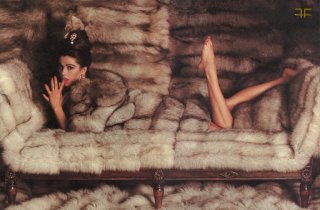j´adore dior
Active Member
- Joined
- Mar 4, 2005
- Messages
- 1,683
- Reaction score
- 2
A truly European sector
Fur farming started at the end of the 19th century in America and spread to Europe at the beginning of 20th century. The main farmed species are mink and fox. Nutria, chinchilla, fitch, sable and fin racoon are bred on a smaller scale.
Today, in many countries, it is an important branch of animal husbandry. 85% of world pelt production originates from farmed species, mostly in Europe. European countries account for 67% of global mink production and 70% of fox production. Fur farms are found in rural areas in almost all European countries.
Housing
The housing systems for farmed fur bearing animals today were developed through independent scientific research and practical experience to respond to the needs of
 the animals. Mink and fox are generally housed in open sided sheds which provide normal temperature and light conditions while protecting the animals from such effects as direct sunlight and rain. Though it is essential for the animals to live outdoors under normal climatic conditions. Each mature animal has its own pen, which always offers sufficient space for normal behaviour and a sleeping area filled with straw.
the animals. Mink and fox are generally housed in open sided sheds which provide normal temperature and light conditions while protecting the animals from such effects as direct sunlight and rain. Though it is essential for the animals to live outdoors under normal climatic conditions. Each mature animal has its own pen, which always offers sufficient space for normal behaviour and a sleeping area filled with straw.
Natural cycle
Breeding fur animals is practised in harmony with the animals' natural life cycle. No hormones or other biological techniques are used to improve breeding results. Once a year mothers raise a litter that is born in the Spring. The cubs stay with their mother until they reach maturity.
 A balanced diet for healthy animals
A balanced diet for healthy animals
Both mink and fox are carnivores. Part of their daily feed is made from fish and poultry by-products, which are unsuitable for human consumption. These primary ingredients are mixed on a fresh day-to-day basis with other ingredients such as cereals, fats, vitamins and minerals. The animals are fed one or several times each day. A balanced diet ensures healthy animals, good breeding and excellent physical development.
Proper health and veterinary care
The state of health among farmed fur bearing animals is generally excellent. Signs of good health include clear bright eyes, good posture, shiny coat, high mating success and inquisitive behaviour. Farmers inspect their animals daily so that veterinary help can be called upon promptly if needed. As a precaution young animals are vaccinated to protect them from botulism, distemper and enteritis.
Fur farming started at the end of the 19th century in America and spread to Europe at the beginning of 20th century. The main farmed species are mink and fox. Nutria, chinchilla, fitch, sable and fin racoon are bred on a smaller scale.
Today, in many countries, it is an important branch of animal husbandry. 85% of world pelt production originates from farmed species, mostly in Europe. European countries account for 67% of global mink production and 70% of fox production. Fur farms are found in rural areas in almost all European countries.
Housing
The housing systems for farmed fur bearing animals today were developed through independent scientific research and practical experience to respond to the needs of

Natural cycle
Breeding fur animals is practised in harmony with the animals' natural life cycle. No hormones or other biological techniques are used to improve breeding results. Once a year mothers raise a litter that is born in the Spring. The cubs stay with their mother until they reach maturity.

Both mink and fox are carnivores. Part of their daily feed is made from fish and poultry by-products, which are unsuitable for human consumption. These primary ingredients are mixed on a fresh day-to-day basis with other ingredients such as cereals, fats, vitamins and minerals. The animals are fed one or several times each day. A balanced diet ensures healthy animals, good breeding and excellent physical development.
Proper health and veterinary care
The state of health among farmed fur bearing animals is generally excellent. Signs of good health include clear bright eyes, good posture, shiny coat, high mating success and inquisitive behaviour. Farmers inspect their animals daily so that veterinary help can be called upon promptly if needed. As a precaution young animals are vaccinated to protect them from botulism, distemper and enteritis.


 its so tacky..
its so tacky.. That said, Ann Landers wore a full-length sable on her walk to work in Chicago each day & I could kinda understand that. Here people break out their furs when it hits 50 degrees F, and I find that unbelievably tacky & pretentious
That said, Ann Landers wore a full-length sable on her walk to work in Chicago each day & I could kinda understand that. Here people break out their furs when it hits 50 degrees F, and I find that unbelievably tacky & pretentious 
